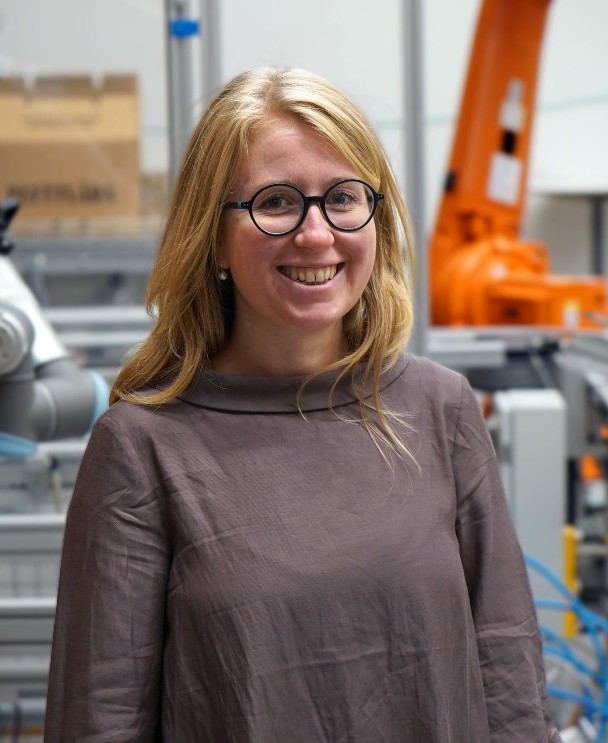A year after Vinnova granted the Digitala Stambanan Produktion project, we are checking the status of the various value chains the project works with. First up is work package 1 (WP1), led by Maja Bärring, Arpita Chari and Dan Li from Chalmers.
Which parties are included in WP1?
WP 1 works with a value chain in the automotive industry where SSAB and Bufab are suppliers to Nitator. SSAB supplies sheet metal to Nitator, which processes it for end customers in the automotive industry. In addition to processing, Nitator also performs some assembly where C parts from Bufab are used, among other things. ChainTraced is a technology provider and provides a solution to digitalize product data. Nitator, Bufab, and ChainTraced were all involved in the previous phase of the Digitala Stambanan.
C parts, could you explain that?
It is typically screws, nuts, and fasteners. Inexpensive high, volume items have a significant impact if unavailable.
What characterizes the value chain?
The delivery service is essential, which places a significant focus on the flexibility of the logistics flow to quickly adapt to the various needs and requests of the end customer, who is often an OEM (Original Equipment Manufacturer) in the Swedish automotive industry.
What do you see as the value chain’s challenges?
There is a lack of data and information shared both up- and downstream in the value chain. There are questions about how customers use existing data and what requirements for data exist in other parts of the value chain.
While we see these as challenges, we also see a great willingness from all parties to learn from each other, which is very positive for the project, says Maja.
Nitator is a smaller player between larger parties in a supply chain. As a small player, it can be challenging to demand things from a larger actor. Having a high degree of flexibility then becomes a competitive advantage. The flexibility puts requirements on their work processes and digitization solutions, which must fit with other parties’ various digitalization solutions.
A challenge for the project is to explore, define and design which data can contribute to such capabilities/development/flexibility within the framework of the project, says Dan.
A vision of the project is to also enhance resilience of the value chain. Data from the digitalization solutions can help the players increase transparency in the value chain, thus adopting a holistic approach in managing disruptions and risk, says Arpita.
So, what have you chosen as focus areas for WP1?
Based on the challenges that the value chain sees and where they see potential to increase the use of data and create value, we have identified four different sub-areas:
- Product data – How data belonging to the product can be used more (for example, SSAB’s material data)
- Delivery assurance – Share data needed to forecast and secure deliveries.
- Customer knowledge – Understand customers’ requirements further down the supply chain.
- Green conversion – Visualize the CO2 footprint in the value chain (traceability of materials and products). This is something that will affect all industries.
What do you want to achieve in WP1?
First, we want to see how the companies in the value chain work today and what maturity level they are at using the maturity assessment Industrie 4.0 Maturity Index. Then we want to address the sub-areas with increased data sharing to see how cooperation can be improved in the value chain. We will do this in different ways, but we start by producing a demonstrator for how CO2 data can be collected and visualized for all parties in the value chain.
In addition, traceability, flexibility, transparency, information sharing and collaboration are some known factors that can impact the resilience of the companies in the value chain. We will then explore how we can utilize the potential of the value from data on the digital platforms to build resilience.
How do you think the work has progressed so far?
In the beginning, project-wide activities got the most attention. Now we can focus more on the value chain itself, where we have gathered support for the focus areas and formulated the questions for the project ahead, thus also setting expectations in more detail. We believe that the overall understanding of the project is beneficial for our future efforts.
The commitment from the participants and interest in the project is higher than our initial expectations. They are open and cooperative and share their experiences. The willingness to spend time learning together with others is vital for a positive project outcome.
Arpita Chari, a PhD candidate and colleague at Chalmers has now joined the project and will help in leading WP1 activities for the coming year. Her research focuses on building resilient and sustainable production systems by utilizing the potential of digital solutions from Industry 4.0.
What lessons have you learned so far?
We have observed that companies often have a lot of data, but it must become more accessible to be used more and create value. Companies often know they have a lot of data but don’t know how to make it available.
How do you see the future? What is your scouting ahead?
We are in a period of time where delivery assurance and logistics have become even more complicated. We have a value chain that chooses to take on these challenges together and help each other instead of trying to solve them alone. It feels promising and is something we believe in. From our perspective at Chalmers, being part of that journey with a value chain that faces these challenges is exciting.
We also see that we are addressing an area that will become increasingly important in the future, such as the CO2 footprint across value networks. It may become a further requirement to collect and show one’s CO2 footprint. How should it then be done and visualized? The interesting part will also be in the following step, how should the companies bring this to their customers and what values can be created moving forward. What is it worth to their customers? So far, it is the price of the product that governs in many cases.
Thank you, Maja and Dan! It will be interesting to follow the further work. Good luck!
Digitala Stambanan strengthens the Swedish industry through digitalization of value chains. The project is a collaborative project financed by Vinnova and participating companies. The work is now underway in two tracks through the strategic innovation programs PiiA (Processindustriell IT & Automation), which drives the Digitala Stambanan IndTech project, and Produktion2030, which runs the Digitala Stambanan Produktion project.





